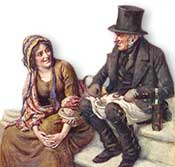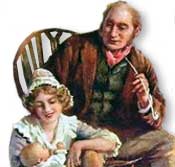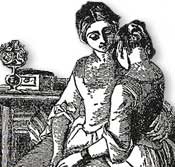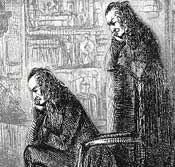The Charles Dickens Page
Charles Dickens'
Christmas Books
A Christmas Carol | The Chimes | Cricket on the Hearth | The Battle of Life | Haunted Man
After the success attained with A Christmas Carol in 1843 Charles Dickens continued the series throughout the 1840s, maintaining what he called "the Carol philosophy" (Letters, 1974, v. 4, p. 328) to to strike a "sledgehammer blow" for the poor, uneducated, and repressed (Ackroyd, 1990, p. 408). In typical Dickens fashion he drove his message home with a mixture of humor and good cheer.
Margaret Lane points out in her introduction to the Christmas Stories "when he had a pill to offer he confected it expertly with spice and sugar" (Christmas Stories, p. vi-vii).
Although subsequent Christmas books sold well at the time of their initial release, they have not enjoyed the staying power of A Christmas Carol (Schlicke, 1999, p. 97).
The Christmas books, particularly The Chimes, the Cricket, and the Carol, were the centerpiece of Dickens' public reading tours in the 1850s and 60s with A Christmas Carol far and away the most popular with audiences.
Dickens discontinued the Christmas books after The Haunted Man, devoting his "spare" time to the publication of weekly magazines, Household Words (1850-1858) and All the Year Round (1859-1867), in which he included annual Christmas stories. These Christmas stories, together with the Christmas books, forever linked Dickens with the celebration of Christmas.
A Christmas Carol - 1843
Read a condensed version | Illustrations | Buy it at Amazon.com
First of the Christmas books and Charles Dickens' most enduring tale. See the A Christmas Carol and Dickens and Christmas pages on this site.
The Chimes - 1844
Illustrations | Buy it at Amazon.com
>Written while Charles Dickens and his family were living in Genoa, Italy, Dickens confessed that he missed the inspiration of the London streets. The story centers around Trotty Veck, a poor ticket porter, whose outlook is converted from despair to hope by the spirits of the chimes on New Year's Eve.
The Chimes is more topical than A Christmas Carol, citing social problems more specific to the 1840s, it therefore lost some of its relevance after the initial release.
Characters:
Character descriptions contain spoilers
|
Veck, Toby (Trotty) Meg Richard Cute, Alderman Filer, Mr |
Bowley, Sir Joseph Fish, Mr Fern, Will Lillian Chickenstalker, Mrs |
The Cricket on the Hearth - 1845
Illustrations | Buy it at Amazon.com
The story centers on John and Dot Peerybingle whose marriage is threatened by a wide difference in their ages. When confronted with the possibility of Dot's infidelity John consults the spirit of the Cricket on the Hearth whose chirping Dot has said brings luck. The cricket assures John that all will be well. In the end the misunderstanding is cleared up and the couple's happiness is restored. The story also features the Scrooge-like conversion of hard-hearted toymaker Tackleton.
Characters:
Character descriptions contain spoilers
|
Fielding, May Fielding, Mrs Peerybingle, John Peerybingle, Mary (Dot) Plummer, Bertha |
Plummer, Caleb Plummer, Edward Slowboy, Tilly Tackleton |
The Battle of Life - 1846
Illustrations | Buy it at Amazon.com
Like previous Christmas books, The Battle of Life centers on a change of heart, but this time without the aid of supernatural beings. Doctor Jeddler's daughters make sacrifices in love which convert their father's cynical view of life.
The least popular of the Christmas books, most critics found it flawed. It is a charming little story...until the ending, which leaves the reader feeling that Dickens just didn't have room to develop it properly under the constraints of the Christmas book format.
The character of Clemency Newcome produces the most enjoyable part of the book, many feel she foreshadowed Clara Peggotty from David Copperfield.
Characters:
Character descriptions contain spoilers
|
Jeddler, Dr Anthony Jeddler, Grace Jeddler, Marion Jeddler, Martha Heathfield, Alfred |
Britain, Benjamin Newcome, Clemency Snitchy and Craggs Warden, Michael |
The Haunted Man - 1848
Illustrations | Buy it at Amazon.com
In Charles Dickens' last Christmas book he returns to the Christmas Carol-like format that began the series in 1843. Mr Redlaw is a chemistry professor tormented by painful memories. He is visited on Christmas Eve by a phantom, a double of himself, who bestows the gift of forgetting these painful memories. The catch is that others who come into contact with the professor also lose remembrance of past hurts and sorrows.
Redlaw passes on this gift to members of the Swidger family, custodians at the university. Philip Swidger, 87-year-old patriarch of the family whose present happiness is based on remembrance of the past, is reduced to senility at Redlaw's touch.
Likewise, the Cratchit-like Tetterby family, touched by Redlaw's gift, become callous and querulous.
In the end the gift is reversed by the inherent goodness of Milly Swidger, whose painful memories of her lost child are the source of her benevolence.
The theme of this Christmas book can be summed up in Philip Swidger's refrain "Lord, keep my memory green" (Christmas Books-The Haunted Man, p. 326).
Characters:
Character descriptions contain spoilers
|
Redlaw Swidger, William Swidger, Milly |
Swidger, Philip Tetterby family Longford, Edmund |
The Nutmeg-Grater Inn
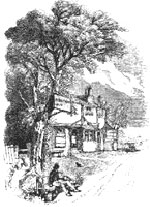 Charles Dickens' description of the Nutmeg-Grater Inn in The Battle of Life is enough to make any weary traveler yearn for such a comfortable respite:
Charles Dickens' description of the Nutmeg-Grater Inn in The Battle of Life is enough to make any weary traveler yearn for such a comfortable respite:
At such a time, one little roadside Inn, snugly sheltered behind a great elm-tree with a rare seat for idlers encircling its capacious bole, addressed a cheerful front towards the traveller, as a house of entertainment ought, and tempted him with many mute but significant assurances of a comfortable welcome. The ruddy sign- board perched up in the tree, with its golden letters winking in the sun, ogled the passer-by, from among the green leaves, like a jolly face, and promised good cheer.
The horse-trough, full of clear fresh water, and the ground below it sprinkled with droppings of fragrant hay, made every horse that passed, prick up his ears. The crimson curtains in the lower rooms, and the pure white hangings in the little bed-chambers above, beckoned, Come in! with every breath of air. Upon the bright green shutters, there were golden legends about beer and ale, and neat wines, and good beds; and an affecting picture of a brown jug frothing over at the top.
Upon the window-sills were flowering plants in bright red pots, which made a lively show against the white front of the house; and in the darkness of the doorway there were streaks of light, which glanced off from the surfaces of bottles and tankards (Christmas Books-The Battle of Life, p. 289-290).

